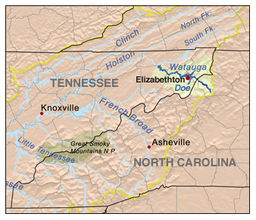Watauga River
| Watagua river | |
| Watoga | |
| River | |
|
The Watauga River near Valle Crucis, North Carolina
|
|
| Name origin: Native American | |
| Country | United States |
|---|---|
| State | NC/TN |
| Regions | Blue Ridge and, Ridge-and-Valley Physiographc Provinces |
| Source | spring |
| - location | Peak Mountain, Avery County, North Carolina [1] |
| - elevation | 4,082 ft (1,244 m) |
| - coordinates | 36°07′25″N 81°50′07″W / 36.12361°N 81.83528°W |
| Mouth | confluence |
| - location |
Holston River, South Fork [2] near Gray, Tennessee, Tri-Cities Region |
| - elevation | 1,384 ft (422 m) |
| - coordinates | 36°26′50″N 82°25′15″W / 36.44722°N 82.42083°WCoordinates: 36°26′50″N 82°25′15″W / 36.44722°N 82.42083°W |
| Length | 78.5 mi (126 km) |
| Basin | 867.849 sq mi (2,248 km2) |
|
Locator - Overview
|
|
|
Watauga River Watershed
|
|
|
Counties touched or traversed by
the Watauga River. |
|
The Watauga /wɑːˈtɑːwɡɑː/ River is a large stream of western North Carolina and East Tennessee. It is 78.5 miles (126.3 km) long with its headwaters on the slopes of Grandfather Mountain and Peak Mountain in Watauga County, North Carolina.
The Watauga River rises from a spring near the base of Peak Mountain at Linville Gap in Avery County, North Carolina. The spring emanates from the western side of the Tennessee Valley Divide, which is, at this location, congruent with the Eastern Continental Divide. On the other side of the divides at Linville Gap are the headwaters of the Linville River in the Upper Catawba Watershed. Waters of the Linville River eventually reach the Atlantic Ocean, whereas waters of the Watauga River reach the Gulf of Mexico; hence the Eastern Continental Divide. The river then flows across Watauga County, North Carolina crossing the Tennessee state line (River Mile (RM) 55.1) at Johnson County, then into Carter County, Tennessee and ends at its confluence with the Holston River's South Fork (RM 0) on the Washington/Sullivan County border.
...
Wikipedia




